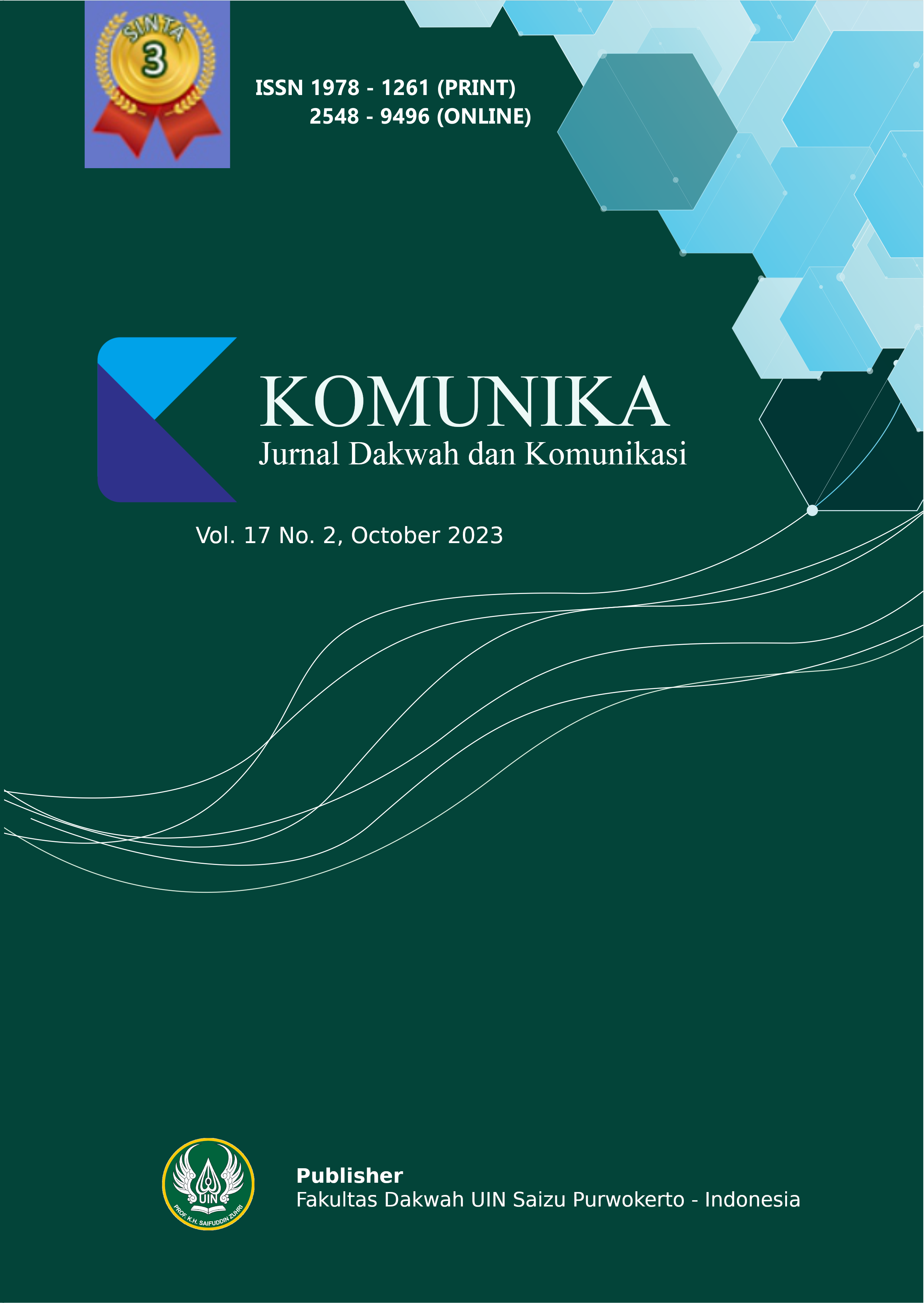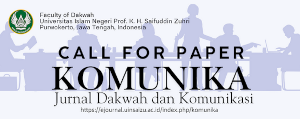Be Real, Do Not Be Fake: A Pilot Study on Universiti Sains Islam Malaysia Students' Fake News Literacy
DOI:
https://doi.org/10.24090/komunika.v17i2.7540Keywords:
media literacy, fake news, new media, communicationsAbstract
If nothing is accomplished to stop it, the virality of fake news on social media will continue to grow and become more damaging, particularly among young people. Recognizing false information and verifying sources has become increasingly important as people rely on the Internet and social media for their news. The primary objective of this study is to assess the level of understanding of fake news media literacy among university students. Forty-three Universiti Sains Islam Malaysia students enrolled in the New Media Communication program were polled for this research. This study uses descriptive statistics to analyze the data collected via Google Forms—the results of examining the data generated immediately through a Google form. Young people read the news online but still have limited media literacy when assessing the truth of information. Research suggests that false statement is commonly discovered because young people do not carefully examine online news. Researchers conduct in-depth interviews and studies with this demographic to better understand how young people process information and evaluate its veracity. This research adds to the expanding body of knowledge on student use of social media in Malaysia, especially on how students get their news in light of the results of this pilot study, the main research project will consist of in-depth interviews with students to understand more about their perspectives on how to identify and differentiate between real and fake news.Downloads
References
Abd-Alrazaq A, Alhuwail D, Househ M, Hamdi M, Shah Z. (2020). Top concerns of tweeters during the COVID-19 pandemic: Infoveillance study. J Med Internet Res, 22 (4) https://doi.org/10.2196/19016
Agarwal, I. Y., Rana, D. P., Shaikh, M., & Poudel, S. (2022). Spatio-temporal approach for classification of COVID-19 pandemic fake news. Social Network Analysis and Mining, 12(1) doi:10.1007/s13278-022-00887-8
Al-Uqdah, L., Franklin, F. A., Chiu, C. -., & Boyd, B. N. (2022). Associations Between Social Media Engagement and Vaccine Hesitancy. Journal of Community Health, 47(4), 577-587. doi:10.1007/s10900-022-01081-9
Aldayel, A., & Magdy, W. (2022). Characterizing the role of bots in polarized stance on social media. Social Network Analysis and Mining, 12(1) doi:10.1007/s13278-022-00858-z
Beauvais, C. (2022). Fake news: Why do we believe it? Joint Bone Spine, 89(4) doi:10.1016/j.jbspin.2022.105371
Berita Harian. (2020). 1.7 juta pelajar hadapi 'miskin digital. Retrieved from https://www.bharian.com.my/berita/nasional/2020/11/757190/17-juta-pelajar-hadapi-miskin-digital
Can, F., Kocberber, S., Baglioglu, O., Kardas, S., Ocalan, H. C., & Uyar, E. (2008). Bilkent news portal. Proceedings of the 31st Annual International ACM SIGIR Conference on Research and Development in Information Retrieval - SIGIR ’08. doi:10.1145/1390334.1390559
Corser, K., Dezuanni, M., & Notley, T. (2022). How news media literacy is taught in Australian classrooms. Australian Educational Researcher, 49(4), 761–777. doi:10.1007/s13384-021-00457-5
Currie, D. H., & Kelly, D. M. (2022). Critical media literacy for uncertain times: Promoting student reflexivity. Journal of Media Literacy Education, 14(2), 15–26. doi:10.23860/JMLE-2022-14-2-2
Ferrari, J. (2022). Bringing digital well-being into the heart of digital media literacies. Journal of Media Literacy Education, 14(2), 72–77. doi:10.23860/JMLE-2022-14-2-6
Friedrichsen, J., Momsen, K., & Piasenti, S. (2022). Ignorance, intention, and stochastic outcomes☆. Journal of Behavioral and Experimental Economics, 100 doi:10.1016/j.socec.2022.101913
Hannah, K., Hattotuwa, S., & Taylor, K. (2022). Media Change, Adaptation and Culture the murmuration of information disorders aotearoa new zealand‚ mis-and disinformation ecologies and the parliament protest. Pacific Journalism Review, 28(1-2), 138-161. doi:10.24135/pjr.v28i1and2.1266
Harari, G. S., & Monteiro, L. H. A. (2022). An epidemic model with pro and anti-vaccine groups. Acta Biotheoretica, 70(3) doi:10.1007/s10441-022-09443-5
Herrero-Diz, P., Conde-Jiménez, J., & Reyes de Cózar, S. (2020). Teens’ motivations to spread fake news on WhatsApp. Social Media and Society, 6(3) doi:10.1177/2056305120942879
Himma-Kadakas, M., & Ojamets, I. (2022). Debunking false information: Investigating journalists’ fact-checking skills. Digital Journalism, 10(5), 866-887. doi:10.1080/21670811.2022.2043173
Horowitz, M., Cushion, S., Dragomir, M., Gutiérrez Manjón, S., & Pantti, M. (2022). A framework for assessing the role of public service media organizations in countering disinformation. Digital Journalism, 10(5), 843-865. doi:10.1080/21670811.2021.1987948
Hung, T. -., & Hung, T. -. (2022). How China's cognitive warfare works: A frontline perspective of Taiwan's anti-disinformation wars. Journal of Global Security Studies, 7(4) doi:10.1093/jogss/ogac016
Johnson, N. R., Paal, K., Waggoner, E., & Bleier, K. (2021). Scales for assessing news literacy education in the digital era. Journalism and Mass Communication Educator, 76(2), 156-175. doi:10.1177/10776958 20930980
Kirn, S. L., & Hinders, M. K. (2022). Ridge count thresholding to uncover coordinated networks during the onset of the covid-19 pandemic. Social Network Analysis and Mining, 12(1) doi:10.1007/s13278-022-00873-0
ksanen, A., Celuch, M., Latikka, R., Oksa, R., & Savela, N. (2022). Hate and harassment in academia: The rising concern of the online environment. Higher Education, 84(3), 541-567. doi:10.1007/s10734-021-00787-4
Kaye, L. K., Rousaki, A., Joyner, L. C., Barrett, L. A. F., & Orchard, L. J. (2022). The online behavior taxonomy: A conceptual framework to understand behavior in computer-mediated communication. Computers in Human Behavior, 137doi:10.1016/j.chb.2022.107443
Macedo-Rouet, M., Potocki, A., Scharrer, L., Ros, C., Stadtler, M., Salmerón, L., & Rouet, J. -. (2019). How good is this page? Benefits and limits of prompting on adolescents' evaluation of web information quality. Reading Research Quarterly, 54(3), 299-321. doi:10.1002/rrq.241
Maksl, A., Craft, S., Ashley, S., & Miller, D. (2017). The usefulness of a news media literacy measure in evaluating a news literacy curriculum. Journalism & Mass Communication Educator, 72(2), 228– 241. https://doi.org/10.1177/1077695816651970
McEwan, C., Szablewska, L., Lewis, K. V., & Nabulime, L. M. (2022). Public-making in a pandemic: The role of street art in East African countries. Political Geography, 98 doi:10.1016/j.polgeo.2022.102692
Michail, D., Kanakaris, N., & Varlamis, I. (2022). Detection of fake news campaigns using graph convolutional networks. International Journal of Information Management Data Insights, 2(2) doi:10.1016/j.jjimei.2022.100104
Monsees, L. (2021). Information disorder, fake news, and the future of democracy. Globalizations, doi:10.1080/14747731.2021.1927470
Moore, R. C., & Hancock, J. T. (2022). A digital media literacy intervention for older adults improves resilience to fake news. Scientific Reports, 12(1) doi:10.1038/s41598-022-08437-0
Marah, I. (2022). Digital media literacy in the age of Mis/Disinformation: The case of Moroccan university students. Digital Education Review, (41), pp. 176–194. doi:10.1344/DER.2022.41.176-194
Musi, E., O’halloran, K., Aloumpi, M., Carmi, E., & Yates, S. (2022). Developing fake news immunity: Fallacies as misinformation triggers during the pandemic. Online Journal of Communication and Media Technologies, 12(3) doi:10.30935/ojcmt/12083
Nam, S. -., & Hwang, H. (2021). Consumers' participation in information-related activities on social media. PLoS ONE, 16(4 April) doi:10.1371/journal.pone.0250248
Omar, S. Z., Kovalan, K., & Bolong, J. (2021). Effect of Age on Information Security Awareness Level among Young Internet Users in Malaysia. International Journal of Academic Research in Business and Social Sciences, 11(19), 245–255.
Rath, B., Salecha, A., & Srivastava, J. (2022). Fake news spreader detection using trust-based strategies in social networks with bot filtration. Social Network Analysis and Mining, 12(1) doi:10.1007/s13278-022-00890-z
Pérez-Escoda, A., Pedrero-Esteban, L. M., Rubio-Romero, J., & Jiménez-Narros, C. (2021). Fake news reaching young people on social networks: Distrust challenging media literacy. Publications, 9(2) doi:10.3390/publications9020024
Sel, B. (2022). Social media use of prospective teachers in the post-truth era: Confirmation, trust, critical thinking tendency. Participatory Educational Research, 9(2), 463–480. doi:10.17275/per.22.49.9.2
Song, H., So, J., Shim, M., Kim, J., Kim, E., & Lee, K. (2023). What message features influence the intention to share misinformation about COVID-19 on social media? The role of efficacy and novelty. Computers in Human Behavior, 138doi:10.1016/j.chb.2022.107439
statista.com (2022).Age group distribution of Internet users in Malaysia in 2020. Retrieved from https://www.statista.com/statistics/981334/malaysia-internet-users-age-g
Syam, H. M., & Nurrahmi, F. (2020). "I Do not know if it is fake or real news" How little do Indonesian university students understand social media literacy? Jurnal Komunikasi: Malaysian Journal of Communication, 36(2), 92-105. doi:10.17576/JKMJC-2020-3602-06
Rubinelli, S., Purnat, T. D., Wilhelm, E., Traicoff, D., Namageyo-Funa, A., Thomson, A., . . . Nguyen, T. (2022). WHO competency framework for health authorities and institutions to manage infodemics: Its development and features.Human Resources for Health, 20(1) doi:10.1186/s12960-022-00733-0
Sinar Harian (2022, Jun 17). MCMC terima 3,285 aduan berita palsu antara 2020 hingga 31 Mei 2022 .Retrieved from https://www.sinarharian.com.my/ampArticle/207472
Umeta, B., Mulugeta, T., Mamo, G., Alemu, S., Berhanu, N., Milkessa, G., . . . Melaku, T. (2022). An analysis of COVID-19 information sources. Journal of Pharmaceutical Policy and Practice, 15(1) doi:10.1186/s40545-022-00446-8
Uppada, S. K., Manasa, K., Vidhathri, B., Harini, R., & Sivaselvan, B. (2022). Novel approaches to fake news and fake account detection in OSNs: User social engagement and visual content-centric model. Social Network Analysis and Mining, 12(1) doi:10.1007/s13278-022-00878-9
Wunderlich, L., Hölig, S., & Hasebrink, U. (2022). Does journalism still matter? The role of journalistic and non-journalistic sources in young peoples' news-related practices. International Journal of Press/Politics, 27(3), 569-588. doi:10.1177/19401612211072547
Yüzgeç, A. Y., & Sütçü, S. S. (2020). The relationship between critical thinking dispositions of prospective English language teachers and their levels of new media literacy. Journal of Language and Linguistic Studies, 16(4), 1952-1967. doi:10.17263/JLLS.851026
Downloads
Published
Issue
Section
License
Copyright (c) 2023 Afiqah Mior Kamarulbaid, Muhammad Raqib Mohd Sofian, Nurul Nadirah Abu Hasan, Nurul Fathihin Mohd Noor Shah, Norsimaa Mustaffa, Hafizuddin Mohamed Najid, Mohd Faridh Hafez Mhd Omar

This work is licensed under a Creative Commons Attribution-ShareAlike 4.0 International License.
Authors who publish with this journal agree to the following terms:
- Authors retain copyright and grant the journal right of first publication with the work simultaneously licensed under a Creative Commons Attribution-ShareAlike 4.0 International License that allows others to share the work with an acknowledgement of the work's authorship and initial publication in this journal.
- Authors are able to enter into separate, additional contractual arrangements for the non-exclusive distribution of the journal's published version of the work (e.g., post it to an institutional repository or publish it in a book), with an acknowledgement of its initial publication in this journal.
- Authors are permitted and encouraged to post their work online (e.g., in institutional repositories or on their website) prior to and during the submission process, as it can lead to productive exchanges, as well as earlier and greater citation of published work (See The Effect of Open Access).

























